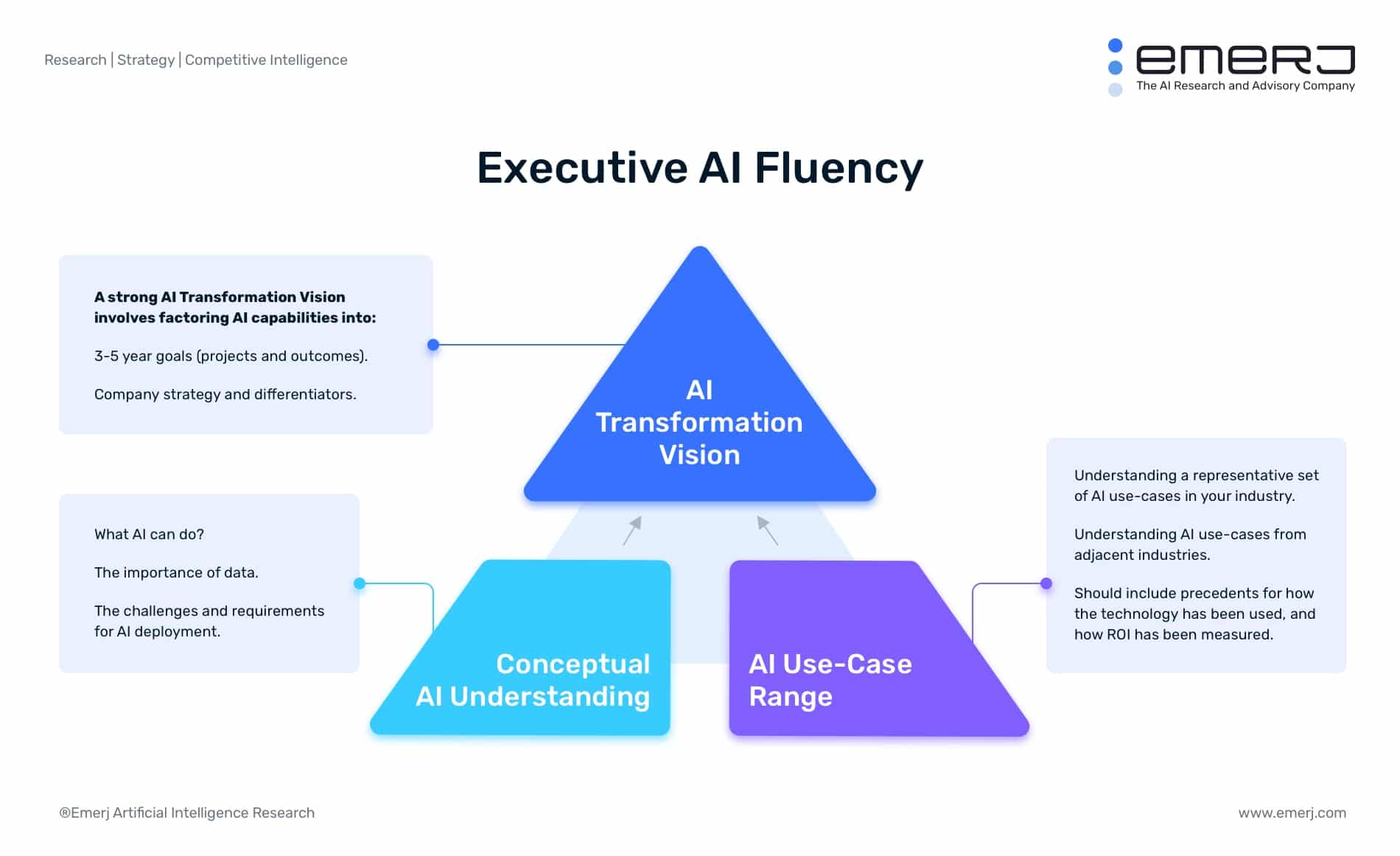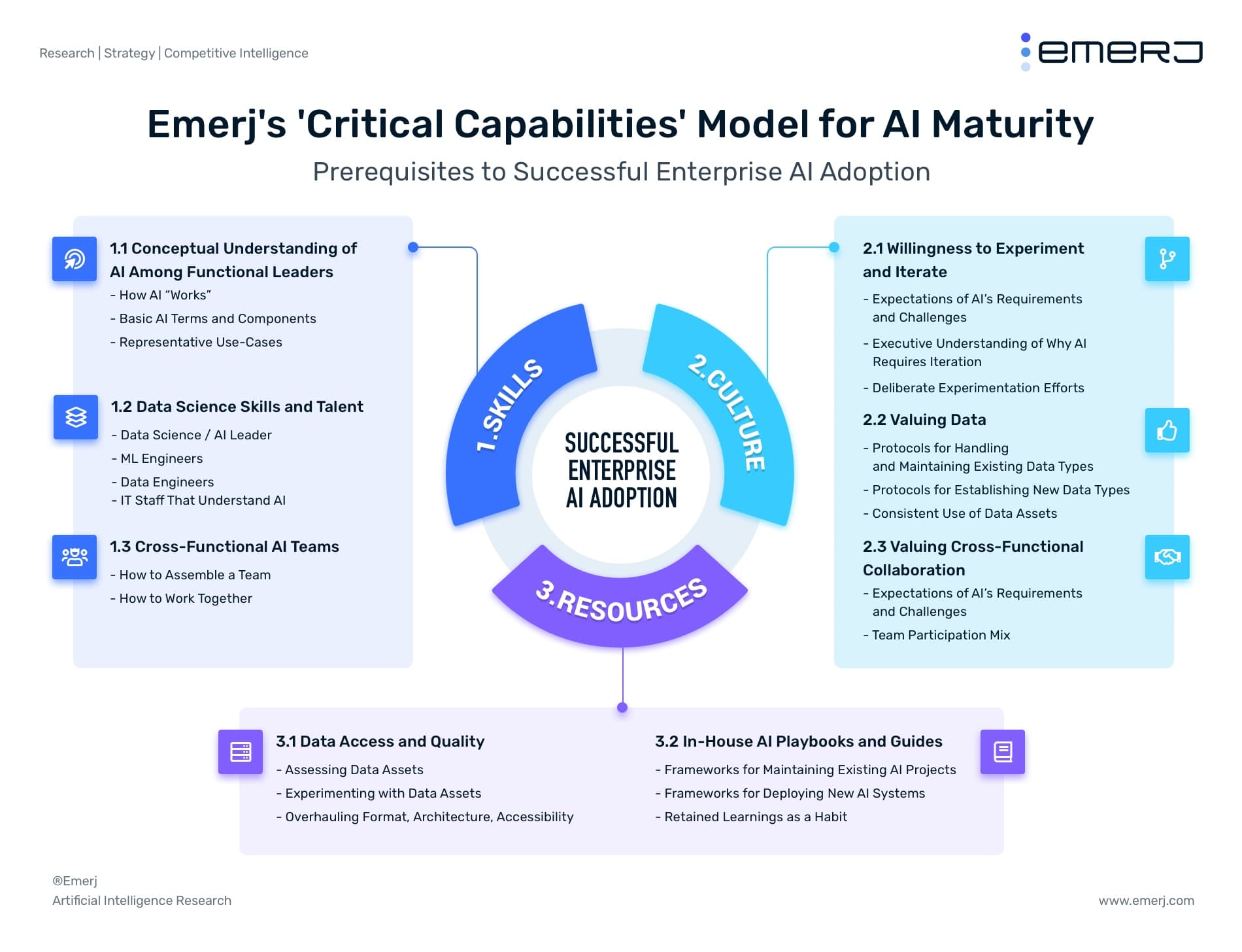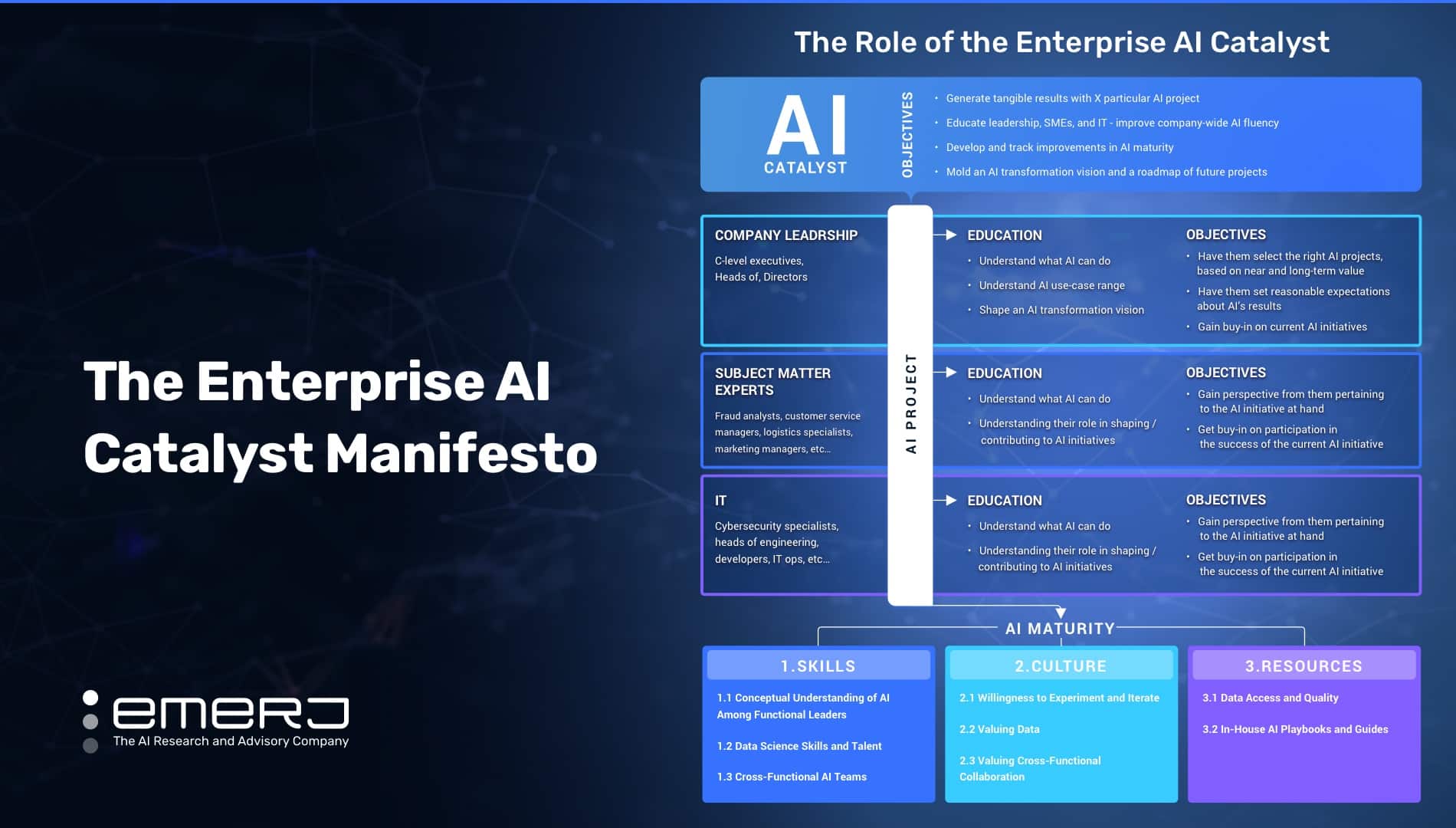Artificial intelligence isn’t making its way into enterprise deployments easily. Despite a relatively widespread understanding that AI is an inevitable force for winning market share and serving customers, by name estimates some 80-90% of AI projects fail.
When AI projects lead to successful deployments and strategic or measurable ROI, it isn’t because the right vendor was chosen, or the right algorithm was used. It’s because someone lead the charge and not only chose the right project – but won the trust and air cover needed to see it through to deployment.
Merriam-Webster defines “catalyst” as:
An agent that provokes or speeds significant change or action.
At Emerj, we refer to an “AI catalyst” as:
Someone who leads their company to AI adoption and ROI.
But what does it mean to “lead” in this context?
Through hundreds of direct interviews with enterprise leaders and industry-leading AI vendors, we’ve come to realize that leading AI change involves much more than picking the right AI projects, or building a team to deploy them. A true AI catalyst isn’t a team member who can write the code, or find initial AI opportunities.
A true AI catalyst takes on multiple demanding responsibilities at once:
- Finding and ranking potential AI opportunities
- Connecting possible AI initiatives to strategic priorities (such as the firm’s existing digital transformation vision)
- Conveying the value of AI initiatives to leadership and getting budget and approval
- Educating subject matter experts on AI’s application to their areas of expertise (this is typically done once a project is approved)
- Educating leadership on what to expect about AI maturity, AI adoption challenges, and the strategic value of AI
We use this graphic with our clients and Catalyst Advisory Program members as way of highlighting the full role of an AI catalyst:

In other words, an AI catalyst takes on the responsibilities of not only a negotiator and a doer, but that of an educator and guide as well.
A catalyst doesn’t write the code, a catalyst forges a vision and aligns stakeholders (including engineers, SMEs, leadership, IT) to approve and execute on a project – and learn from the process.
While the responsibilities are significant, the benefits of leading AI change in an enterprise can yield significant benefits for those who step up to the challenge.
For internal AI project leaders, winning early AI traction implies not only contributing to company goals in an important way, but it also implies a strong likelihood of involvement in future AI projects. In my article on the AI career gap, I stated that practical enterprise AI experience is much more rare than an MBA, and will soon command a much higher premium on the job market.
For AI consultants and service providers, catalyzing AI adoption with AI clients not only builds trust through education, but it’s also the best way to encourage the success of an AI project (in part, by setting the right expectations and picking the right projects) and set yourself up for a roadmap of transformation – as opposed to a handful of dead-end proofs of concept.
In this article, we’ll cover the following topics in order:
- Why AI catalysts are necessary
- Who can be an AI catalyst
- Who catalysts need to influence
- AI catalysts as a conduit to AI maturity
- Advice for aspiring AI catalysts
Why AI Catalysts are Necessary

AI catalysts have a level of AI fluency that allows them to educated team members, orchestrate team members, and drive AI project results – without writing code.
Before we cover why AI catalysts are necessary, we’ll briefly cover the three elements of AI fluency, and what a catalyst needs to understand.
How AI Works:
- What factors influence the team, data, and resource requirements for an AI project.
- What a typical enterprise AI deployment roadmap looks like.
AI Use-Case Range:
- A conceptual grasp of the most important or common AI use-cases at work in your industry.
- How data is used and how success is measured for these use cases.
AI Transformation Vision:
- How AI aligns with our 3-5 year goals, strategic differentiators, and current priorities.
- How AI might unlock new business models or new ways to deliver value for our customers.
These three topics aren’t impossibly hard to do. In our advisory work, we’re often able to get an innovation or strategy team to a reasonable level of AI fluency – in the top 5% of their peers – in 6-8 hours of reading and Q-and-A. At a basic level, this kind of AI fluency grants non-technical leaders the ability to the point where they can spot their own AI opportunities, roughly estimate resource requirements and safely differentiate realistic vendor claims from hype.
If educating stakeholders and developing AI fluency is important, and not terribly time consuming, then we might expect that within a few years, executive leadership (CEOs, CTOs, COOs, even board members) will have said fluency, and the wrestling match of conveying AI’s value and AI concepts to executive leadership won’t be a challenge anymore.
While the average C-level leader is more AI fluent than they were three or four years ago, most AI change is coming from motivated directors, Heads of, VPs – and usually a combination of outside advisors – not from the C-level itself.
The C-suite doesn’t have the time. Most C-suite leaders don’t have the time to develop AI fluency on their own – or at least not a sufficient degree. It’s their direct reports who are getting MIT business strategy online course certifications. It’s their direct reports who are listening to Emerj’s podcast or getting Emerj Plus memberships. It’s their direct reports who attend AI webinars. The C-suite is managing the entire business, but functional leaders below them – particularly leaders with mandates for innovation and strategy – can spend the time to find potential AI fits, and get themselves up to speed on the technology broadly.
For better or worse, projects are the gateway to executive AI fluency. The way the C-suite learns AI fluency is often the same way that SMEs develop AI fluency – when they’re involved in a project. The C-suite learns about AI only when they have interaction with an AI project leader in the form of updates and guidance on AI initiatives. Only when money has been committed and expectations are on the line does most C-suite leadership have the time or motivation to look under the hood at AI problems and understand the context around how AI works, and how it ties to strategy. AI projects are no guarantee the C-suite leadership will come out smarter – but it provides the AI catalyst with an opportunity to ensure that AI fluency is built.
Who Can be an AI Catalyst
Internal AI catalysts. Within the enterprise, functional business leaders often take the helm on leading AI change. In most cases, the internal catalyst has no ML engineering or data science skills. Instead, they have a broad understanding of the businesses various operations, and strong connections horizontally and vertically within the firm. Sometimes this person is a Head of Innovation, Strategy, or Digital Transformation. Sometimes it’s a director or VP within a specific division.
These leaders often have:
- A mandate to drive digital transformation or AI initiatives
- An ability to be involved in company-wide technology initiatives (i.e. they aren’t locked into one division or department – must have the ability to broaden their influence)
- A career or personal ambition that drives them to be a genuine change-maker within their organization, to imagine and frame new ways of doing things
- A strong fundamental AI fluency built up from self-study, research, and conversations with peers and/or vendors
External AI catalysts. External AI catalysts are typically technology integrators or IT/strategy consulting firms. Most AI vendor firms are unable to reliably serve as real educators and enablers of AI change, because their business model doesn’t allow for it.
As we’ve covered in our article series about AI business models, most AI product firms are incentivized to study a single problem, plug in their solution, and do as little white-glove consulting and education as possible. This doesn’t make them bad companies – AI vendor products are often very competent at the specific problem of focus, but not much else. An AI strategy or technology consultancy likely sees a much wider variety of problems, and is incentivized to gear up
In short, AI product firms make their money by integrating and then sending an invoice every year, and AI consultancies make their money by “selling work,” and involving themselves in more projects with a client. This latter model more naturally lends itself to the role of an advisor, and a partner for broad transformation. It doesn’t mean that consultancies all have their clients’ best interests in mind, but it does mean that they’re much more likely than an average vendor company to be able to catalyze cultural change and a holistic AI vision.
Enterprises should look for AI consultants and advisors that have:
- Robust experience with AI projects and strategies at other firms (preferably in your same industry)
- A strong fundamental AI fluency built up from self-study, research, and conversations with others clients and vendors
Some external AI catalysts offer ML engineering, technical integration, and data science work. Others are non-technical, and serve the purpose of informing strategy, educating leadership, discovering AI projects, competitive intelligence into the AI investments of peers in your industry, etc.
Who AI Catalysts Need to Influence
Ultimately, an AI catalyst needs to influence and educate everyone who plays a part in the AI project that they’re driving forward – from the executive who approves it, to the front-line SME who helps them label the data. Ideally, every role involved in AI projects should have higher level of AI fluency (see the three elements of AI fluency listed previously) after initial proof of concept or deployment is completed.
Three kinds of stakeholders should be mentioned directly:
Company leadership – C-level executives or leadership working directly with the C-suite – these are the people who sign off on big projects and steer grand strategy.
Critical skills for working with company leadership:
- The ability to present AI project ideas and present the ROI case for AI projects
- The ability to set reasonable expectations about the near and long-term impact of AI projects (neither under-selling or over-selling)
Subject matter experts – from customer service to fraud detection to accounting, these are the people who serve a functional day-to-day job and understand their workflow better than anyone else in the company.
Catalysts who work with SMEs successfully are able to conceptually explain the SME’s role in the AI project (for example: helping to determining important data features for a recommendation engine, or labeling fraud data to train a fraud detection system, etc), as well as how those inputs fit into the broader picture of the AI project itself (i.e. why the SME’s help with feature engineering is critical to the project’s success, and how this will help with the rest of the project).
IT team – from network administrators to hardware technicians to IT project managers, these people keep the information systems of the company up and working.
IT is almost always in a state of overwhelm, and AI projects typically come across as threatening to IT teams in three ways:
- First, IT staff knows that much of the integration, infrastructure, and security considerations of AI projects will fall on their lap
- Second, they often feel like AI projects will threaten to automate their work, or shift power and influence away from old “IT” and towards new and shiny “AI”
- Third, they often feel challenged by AI vendors or consultants, and feel that they could get the job done themselves better than any outside firms could
Smart AI catalysts build allies in IT – team members who see the value of AI, and see how IT could contribute to AI initiatives and capabilities, not simply be responsible for delivering on what can feel like the muck-work of AI projects. Even if IT isn’t enthusiastically leading the charge around AI projects (which almost never happens), IT staff involved in AI projects can be taught how AI works, and how to spot opportunities and add AI value of their own. They can also be an important part in developing runbooks for AI-related processes.
AI Catalysts as a Conduit to AI Maturity

An AI catalyst is critical to driving successful AI projects – but a company’s long-term ability to wield AI profitably is not based entirely on the success of independent AI point-solutions being.
It is based on the AI maturity that a firm develops through those projects, and through working together in new ways.
AI maturity involves three critical elements:
- Skills
- Culture
- Resources
An AI catalyst serves the all-important role of lifting the conceptual understanding of team members, and in so doing, gradually changing culture through shared experience.
This maturity-building is one of the core elements of AI ROI, especially for early projects.
Skills and culture won’t change without a catalyst who can not only find and move forward on initial projects, but who can use those projects as conduits to leveling up their teams and executives.
Advice for Aspiring AI Catalysts
Whether you’re an internal AI project leader or an outside consultant, your career journey begins with educating yourself now, and building the fundamental skills that will make you more valuable in the future:
- Stay ahead. Stay abreast of AI developments and use-cases in your industry, find social handles and newsletters to follow. You may want to subscribe to the AI in Business podcast or other audio media as well.
- Get in early. Find ways to get involved in leading early AI projects (possibly by identifying them yourself). Practical experiene with enteprise AI projects is rare, and if you roll up your sleeves and help drive a project forward, the lessons you’ll learn about AI teams, data infrastructure, security, etc will make you more valuable for the next project, or for a future role along your career path.
- Tactfully communicate. SMEs, executives, and IT leaders have different motives, incentives, and concerns. If you’re planning to lead AI change, you’ll need the ability to sell. Selling SMEs to join your project team. Selling executives on the near and long-term value of an AI initiatives. Read our executive guide about setting the right expectations upfront for AI projects.
The responsibility required for leading AI change isn’t for everyone, but the fact of the matter is this: Enterprise firms won’t sustainably change unless internal catalysts lead the charge towards AI maturity, and early project success. If you choose to become a catalyst, you’re taking on more responsibility, but you’re also opening up opportunities for new capability and growth.
The Emerj Catalyst Advisory Program
If you’re an AI consultant or service provider, or you aspire to become one, consider learning more about Emerj’s Catalyst Advisory Program. The program is designed to help AI services firms:
- Go to market with confidence
- Land and expand AI service business with enterprise firms, and
- Deliver more AI value for clients
Combining proven frameworks and playbooks with one-to-one advisory and access to a network of ambitious peers, Catalyst sets its members up for success.

Catalyst is composed of a small, hand-selected group of small and mid-sized AI services leaders. Some Catalyst members have technical teams, while others offer purely strategy-oriented services. Some have established firms, while other members use Catalyst to start their new firms with confidence and momentum – and without reinventing the wheel.
Learn more about Catalyst via the link below:




















